Physical Address
304 North Cardinal St.
Dorchester Center, MA 02124
Diseases affecting central nervous system (CNS) myelin can be classified on the basis of whether a primary biochemical abnormality of myelin exists (dysmyelinating) or whether some other process damages the myelin or oligodendroglial cell (demyelinating) . Demyelinating diseases in which normal myelin is disrupted include autoimmune, infectious, toxic and metabolic, and vascular processes. Dysmyelinating diseases in which a primary abnormality of the formation of myelin exists include several hereditary disorders. Infectious demyelinating disease (progressive multifocal leukoencephalopathy [PML]), toxic and metabolic demyelinating diseases, and vascular demyelinating disease (Binswanger disease) are discussed elsewhere. The present chapter concentrates on multiple sclerosis (MS) and other inflammatory demyelinating diseases of myelin as well as other CNS diseases that are presumably immune mediated ( Box 80.1 )
Acute disseminated encephalomyelitis
Acute hemorrhagic leukoencephalopathy
Multiple sclerosis
Progressive multifocal leukoencephalopathy
Carbon monoxide poisoning
Vitamin B 12 deficiency
Mercury intoxication (Minamata disease)
Alcohol/tobacco amblyopia
Central pontine myelinolysis
Marchiafava-Bignami syndrome
Hypoxia
Radiation
Binswanger disease
Adrenoleukodystrophy
Metachromatic leukodystrophy
Krabbe disease
Alexander disease
Canavan-van Bogaert-Bertrand disease
Pelizaeus-Merzbacher disease
Phenylketonuria
MS is classically described as principally a demyelinating disorder that affects multiple white matter tracts within the CNS. The variability of MS in clinical presentation is well known. This heterogeneity includes age of onset, mode of initial manifestation, frequency, severity and sequelae of relapses, extent of progression, and cumulative deficit over time, as will be discussed across this chapter. The clinical features reflect the widespread distribution of CNS injury, and we will begin with an overview of the signs and symptoms of this disease, referable to characteristic demyelinating localizations: optic neuritis (ON), brainstem, and spinal cord.
ON, inflammation at any point of the optic nerve, is common at some point in the course of patients with relapsing MS, and frequently it may be the presenting symptom. The optic nerve is the most commonly affected site of the visual pathway. It usually manifests as an acute or subacute unilateral syndrome characterized by pain in the eye that is accentuated by ocular movements, followed by a variable degree of visual loss affecting mainly central vision and sometimes decreased color vision as well. Patients with ON often have a relative afferent pupillary defect (Marcus Gunn pupil) and most have a normal fundoscopic exam; papillitis is rarely seen. Mapping of visual fields reveals a central or cecocentral scotoma (central scotoma involving the physiological blind spot). After an attack of acute ON, 90% of patients regain normal vision, typically over a period of 2–6 months.
It is important to note that bilateral, simultaneous ON is rare in MS, and its occurrence may suggest another diagnosis such as Leber hereditary optic neuropathy, toxic optic neuropathy, neuromyelitis optica, or anti-MOG antibody associated ON. In bilateral ON in MS cases, the impairment usually begins asymmetrically and is more severe in one eye.
Impairment of individual ocular motor nerves is infrequent in MS but may occur in isolation or as part of a brainstem syndrome. When present, the involved nerves are, in decreasing order of frequency, cranial nerves VI, III, and (rarely) IV.
Brainstem syndromes in MS causing eye movement abnormalities are frequently those that reflect lesions of vestibulo-ocular connections and internuclear connections. Nystagmus is a common finding in MS. One form of nystagmus particularly characteristic of MS is acquired pendular nystagmus , in which there are rapid small-amplitude pendular oscillations of the eyes in the primary position. Patients frequently complain of oscillopsia (subjective oscillation of objects in the field of vision). This type of nystagmus is most often bilateral, but can also be unilateral and may be seen as consequent of an optic neuropathy, or because of involvement in the cerebellum or dorsal pontine tegmentum ( ).
Internuclear ophthalmoplegia (INO), defined as abnormal horizontal ocular movements with lost or impaired adduction and horizontal nystagmus of the abducting eye, is secondary to a lesion of the medial longitudinal fasciculus on the side of diminished adduction. Convergence is preserved. When present bilaterally, it is usually coupled with vertical nystagmus on upward gaze. Often a patient with an INO does not complain of a visual disturbance and it is instead recognized first by the examiner. Ocular pursuit movements are frequently saccadic rather than smooth. In the appropriate epidemiological context, the identification of an INO is highly suggestive of MS and should prompt a work-up for this diagnosis.
Impairment of facial sensation—subjective or objective—is a relatively common finding in MS and may occur in isolation or as part of a hemisensory syndrome. The occurrence of trigeminal neuralgia in a young adult may prompt a work-up for MS, yet is an uncommon presenting symptom and, if it occurs, it is typically later in the course. Facial myokymia , a fine, undulating wavelike facial twitching, and hemifacial spasm can be caused by MS, but other causes of a focal brainstem lesion must be excluded ( ). Unilateral facial paresis can occur. Complete hearing loss, usually unilateral, is an infrequent complaint. Isolated dysfunction of taste sensation is rare but has been well characterized with localization to the brainstem ( ). Malfunction of the lower cranial nerves is usually of the upper motor neuron type (pseudobulbar syndrome) and a rather late finding in MS. Vertigo is a reported symptom in 30%–50% of patients with MS and is commonly associated with dysfunction of adjacent brainstem or cranial nerves.
Cerebellar pathway impairment, due to a lesion or lesions in the posterior fossa, results in gait imbalance, difficulty performing coordinated actions with the arms, and slurred speech. Examination reveals the usual features of cerebellar dysfunction. Ocular findings of nystagmus, ocular dysmetria, and frequent refixation saccades suggesting cerebellar or cerebellovestibular connection dysfunction are common. Speech can be either scanning or explosive in character. Dysmetria, decomposition of complex movements, and hypotonia are most often observed in the upper extremities. An intention tremor in the limbs and titubation of the head may be seen. Walking is impaired by ataxia. In severe cases, even with full strength, there is inability to use the arms because of a violent intention tremor and inability to stand. Such profound impairment of cerebellar function is rarely the permanent residua of acute relapse, and instead is typically a manifestation of progressive MS.
Spinal cord white-matter lesions are common in MS, and as such, sensory manifestations are a frequent initial feature of MS and are present in almost every patient at some time during the course of disease. The sensory features can reflect spinothalamic, posterior column, or dorsal root entry zone lesions. The sensory symptoms are commonly described as numbness, tingling, pins and needles, tightness, coldness, itching, or a feeling of swelling of limbs or trunk. Radicular sensations, unilateral or bilateral, can be present, and a bandlike abdominal sensation may be described, euphemistically described as “the MS hug.”
The most frequent sensory abnormalities on clinical examination are varying degrees of impairment of vibration and joint position sense, decrease of pain and light touch in a distal distribution in the four extremities, and patchy areas of reduced pain and light touch perception in the limbs and trunk. A bilateral sensory level, frequently ascending in character, is a more frequent finding than a hemisensory spinal cord (Brown-Séquard) syndrome.
The deafferented “useless” hand is a characteristic but uncommon feature, consisting of an impairment of function secondary to a pronounced alteration of proprioception, without loss of power. A lesion of the relevant root entry zones or posterior columns in the spinal cord may be responsible in such cases.
Corticospinal tract dysfunction is common in MS, and can occur in the setting of acute relapse or progressive disease. Weakness as a result of a relapse, typically due to a partial myelitis affecting motor pathways, can involve one or all limbs, although a devastating relapse resulting in permanent inability to walk is exceedingly rare. More commonly, sustained motor weakness can be either partial, as the residual of a relapse, or worsen gradually as a result of progressive disease. Paraparesis, or paraplegia with a lower extremity preponderance, occurs more frequently than significant weakness in the upper extremities ( ). A hemiparesis sparing the face is also common. Most patients with weakness develop spasticity to some degree. This can manifest as a feeling of muscle tightness, cramping, and stiffness with walking. In advanced cases of paralysis and severe spasticity, joint contractures may occur. The physical findings include an increased spastic tone, usually more marked in the legs than in the arms. The deep tendon reflexes of the affected limbs are exaggerated, sustained clonus may be elicited, and extensor plantar responses are observed. Occasionally, reduced reflexes reflect hypotonia due to cerebellar pathway lesions. Amyotrophy, when observed, most frequently affects the small muscles of the hand; lesions of the motor root exit zones may produce muscle denervation secondary to axon loss.
The extent of sphincter and sexual dysfunction is typically the consequence of MS-related myelopathy, and often parallels the degree of motor impairment in the lower extremities. The most common complaint related to urinary bladder dysfunction is initially urgency, usually the result of uninhibited detrusor contraction, reflecting a suprasegmental lesion. As the disease progresses, urinary incontinence due to urgency becomes more frequent. With involvement of sacral segments of the spinal cord, symptoms of bladder hypoactivity may evolve (e.g., decreased urinary flow, interrupted micturition, incomplete bladder emptying). An atonic dilated bladder that empties by overflow results from loss of perception of bladder fullness and is usually associated with urethral as well as anal and genital hypoesthesia, and sensory deficits in the sacral dermatomes. A dyssynergic voluntary sphincter that interrupts bladder emptying will lead to frequent, small-volume urinations combined with a large postvoid residual. Urinary tract infections are common in MS, especially in women, and may present in atypical patterns without hallmark pain due to concomitant interruption of ascending nociceptive signal in the spinal cord.
Constipation is very common and is generally due to a combination of factors: spinal cord involvement, decreased general mobility, dietary issues, and the tendency of some patients to restrict their fluid intake in a misguided attempt to decrease urinary urgency and incontinence. Almost all patients with paraplegia require special measures to maintain regular bowel movements. Bowel urgency can also be a troubling symptom for patients.
Sexual dysfunction, although frequently overlooked, occurs in 40%–80% of patients with MS ( ). Men experience various degrees of erectile dysfunction, often trouble maintaining erection, whereas inability to ejaculate is less common. Sexual dysfunction in women manifests as inability to orgasm and decreased libido. Sexual dysfunction can be the result of multiple problems, including the direct effects of lesions on the motor, sensory, and autonomic pathways within the spinal cord as well as psychological factors that affect libido: depression, self-image, self-esteem, and fear of rejection by the sexual partner. Mechanical difficulties created by spasticity, paraparesis, and incontinence may further aggravate the problem.
The symptoms and signs of MS are the result of the pathological process that occurs in the CNS. In early relapsing disease, new lesion formation is responsible for acute symptom development. In the natural history of the disease state, a progressive phenotype develops in most; axonal loss then results in the gradual accumulation of neurological deficit.
A comparison of the physiological properties of normally myelinated axons and demyelinated axons provides insight into the disease process. Compacted myelin is the lipid-rich plasma membrane of oligodendrocytes that provides insulation for electrical impulses traveling along axons. Myelinated axons propagate nerve impulses rapidly in a saltatory fashion, with a high safety factor for transmission (five to seven times above threshold). Current is induced by the opening of voltage-gated Na + channels found at the nodes of Ranvier. The resultant Na + influx creates a current that then moves toward the next node of Ranvier, as current cannot flow outward in myelinated internodal segments ( Fig. 80.1 ). K + channel opening terminates current flow and leads to repolarization. Several types of K + channels exist in the axon. Fast K + channels sensitive to 4-aminopyridine are located in internodal axonal membrane and contribute to repolarization of demyelinated axons. Slow K + channels are found at the nodes of Ranvier and have a role in modulating repetitive firing. The Na + /K + -adenosine triphosphatase (ATPase) in the axon membrane restores ionic balance after high-frequency firing.
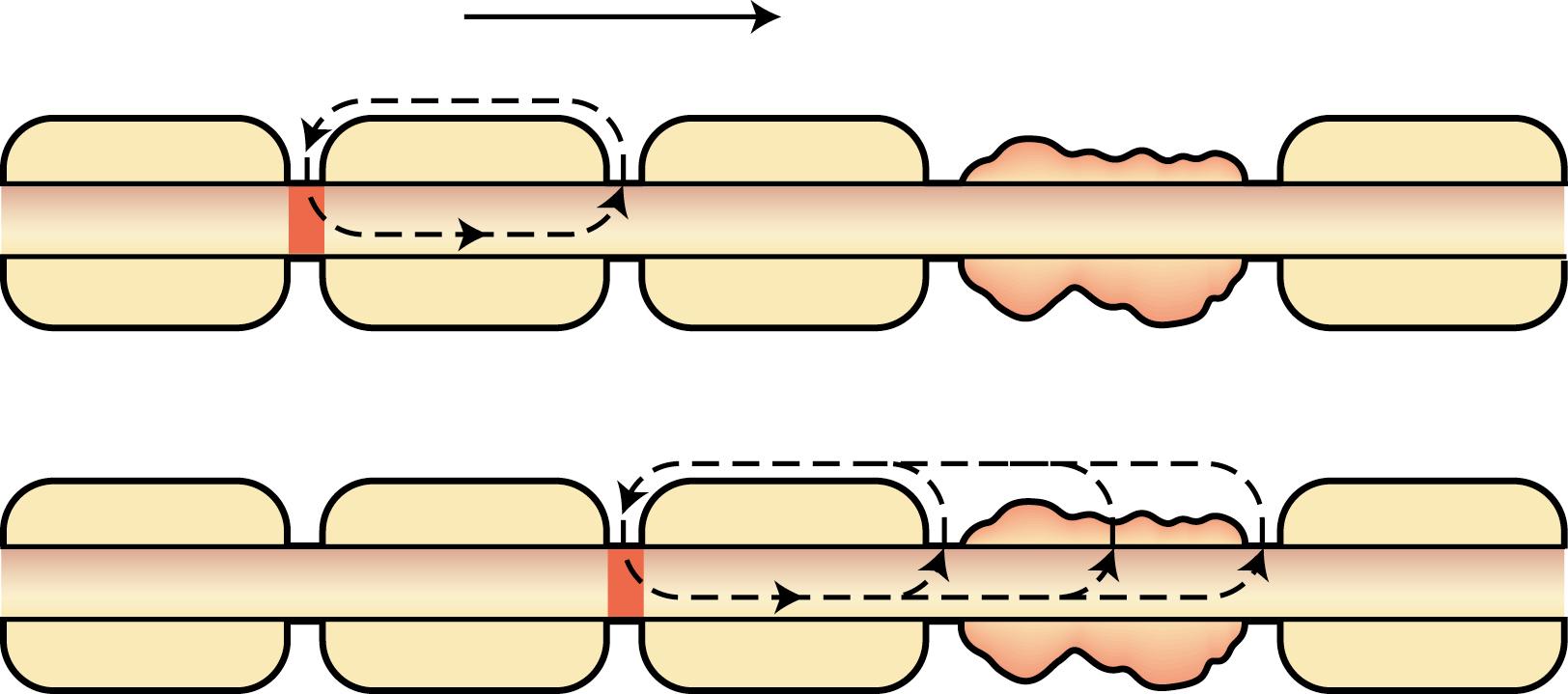
Demyelination interrupts current flow by removing the insulator of internodal axon current flow. After a relapse, remyelination occurs with recovery of clinical function to some degree in most cases. Transient worsening of function reflects a drop below the safety threshold for conduction because of physiological changes involving the partially demyelinated axon. This explains the characteristic Uhthoff phenomenon, a temporary worsening of previous symptoms with increased body temperature. To contrast, persistent neurological deficit happens in areas that have been less completely myelinated. In those regions, severe conduction block remains or severe axonal destruction has taken place.
Although debated, it is generally thought that activation of myelin-specific T cells in the periphery precede the formation of an MS lesion, as opposed to a CNS location as the origin of attack. The trigger for each relapse is generally unknown, though some relapses may occur after immune system activation secondary to a viral infection, or in the postpartum setting. One of the earliest features of acute MS lesion formation is the interruption of the blood-brain barrier (BBB). The BBB normally functions to regulate protein transport and ion concentration, and to block pathogens and immune cells from CNS entry. It is composed of a thick membrane of glycocalyx, non-fenestrated endothelial cells, a vascular basement membrane, the glia limitans, and astrocytic end-feet. The endothelial cells of the BBB are connected through tight junctions ( ).
During a relapse, activated CD4 T cells are likely the first to enter the CNS, bringing a plethora of immune cells behind. Grossly, the pathological hallmark of MS is the cerebral or spinal plaque, which consists of a discrete region of demyelination with relative preservation of axons, although spectroscopic and pathological studies suggest some axonal loss may be an integral part of the disease process. Examination of the brain in MS often reveals atrophy and ventricular dilatation. Plaques may be visible on the surface of the spinal cord on inspection. The cut surface of the brain reveals the plaques, which when active, appear whitish yellow or pink with somewhat indistinct borders. Older plaques appear translucent with a blue-gray discoloration and sharply demarcated margins. Individual lesions are generally small (1–2 cm) but may become confluent, generating large plaques. Plaques develop in a perivenular distribution and are seen most frequently in the periventricular white-matter, brainstem, and spinal cord ( Figs. 80.2 and 80.3 ), a finding confirmed with magnetic resonance imaging (MRI) studies. However, large numbers of small plaques, often detected only by microscopy, are found in cortical regions affecting intracortical myelinated fibers. Histological examination of active plaques has revealed abnormal infiltration of lymphocytes, monocytes, and macrophages, with occasional plasma cells around a central vein. The process then propagates radially ( ) and myelin is disrupted, resulting in myelin debris found in clumps and within lipid-laden “foamy” macrophages. Reactive astrocytes are prominent in plaques. Immunohistochemical studies have found increased levels of cytokines in active plaques, indicative of ongoing immunoreactivity.
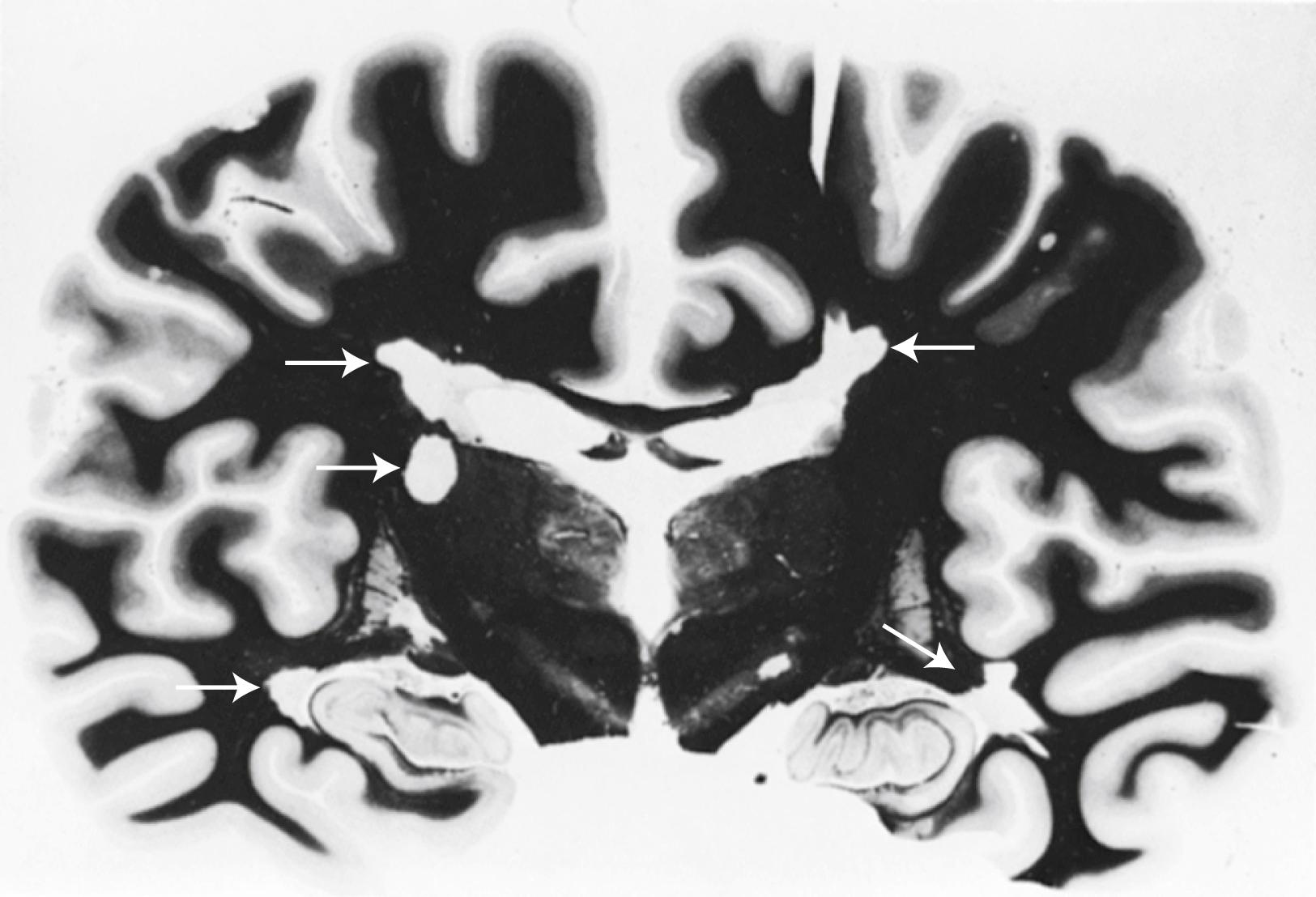
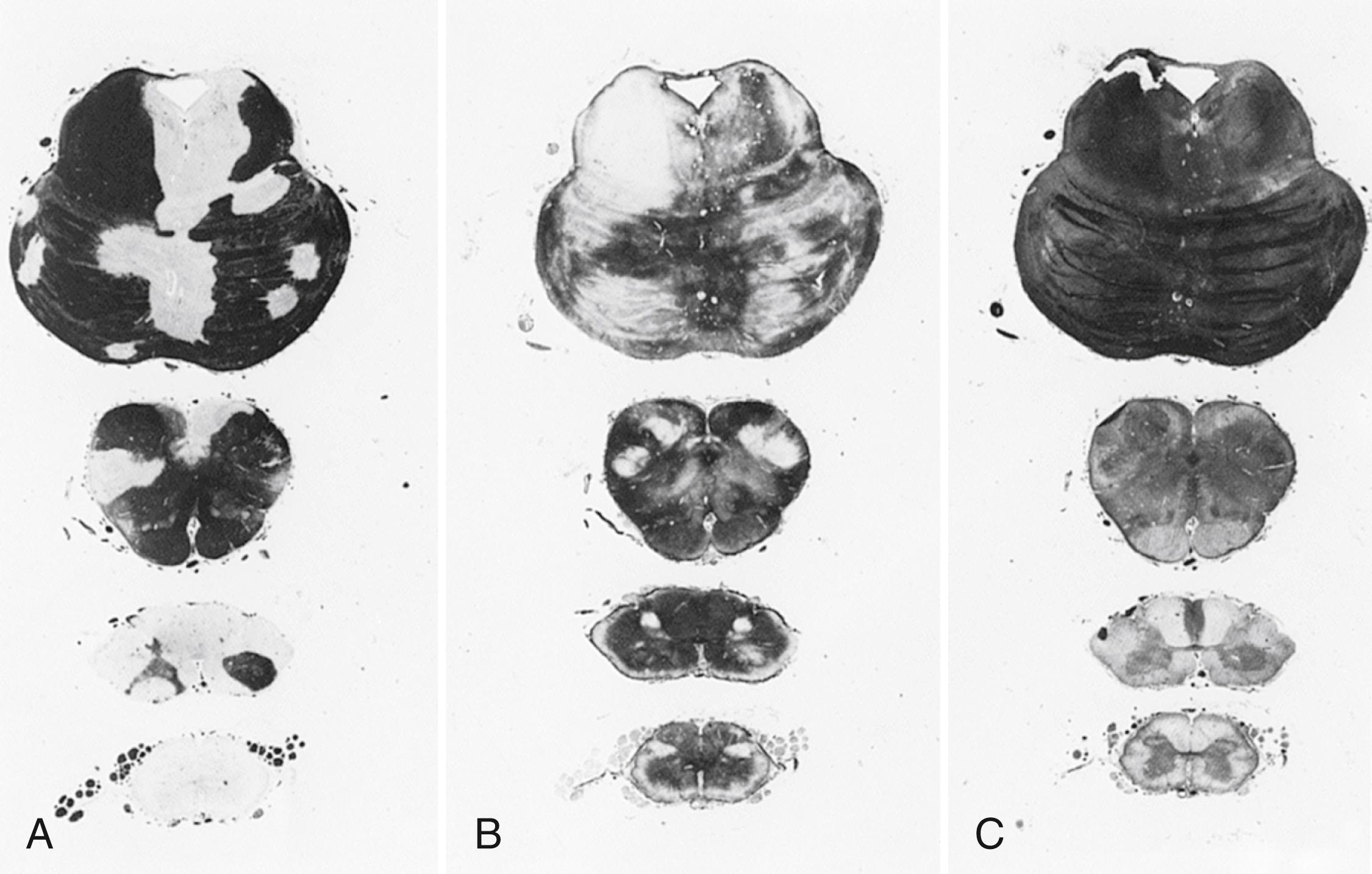
Oligodendroglia numbers are reduced proportionate to myelin loss in the plaque center, whereas at the plaque edge, oligodendroglia are preserved or even increased, suggesting an attempt at remyelination. Remyelination may involve either oligodendrocytes that previously produced myelin or maturation of progenitor cells. Such remyelination may explain the clinical finding of slow and delayed recovery from an acute attack, whereas rapid clinical recovery presumably reflects the resolution of edema, inflammation, and removal of toxic factors associated with acute plaques in which myelin destruction is minimal. Pathological studies demonstrate that the extent of remyelination can be quite extensive, even in patients with progressive disease ( ).
Data derived from biopsy as well as autopsy material ( ) have emphasized the heterogeneity of the MS lesion. These investigators have described four distinct pathological patterns. Some lesions appear to be chiefly inflammatory (types I and II), with retention of active oligodendrocytes derived from identifiable precursor cells and evidence of remyelination. The most common pathological pattern seen (type II) had inflammatory infiltrates and deposition of complement and immunoglobulin (Ig)G. In other patients, extensive destruction of oligodendrocytes, little replacement, and closer resemblance to a viral or toxic cell apoptosis or necrosis was found (types III and IV). All active lesions from an individual patient were of the same type. A follow-up to this study reported that patients with repeat biopsies continued to exhibit the same pathological subtype over time ( ). The specific target of the immune-mediated injury in MS remains undetermined.
Lymphocytes in the lesion are specifically sensitized to myelin antigens. Reports vary with regard to the extent of restriction and the precise profile of the T-cell receptor repertoire of CNS T cells. T-cell sensitization could occur via direct exposure to myelin antigens within the CNS or within cervical lymph nodes, a site to which CNS antigens are transported through draining, or via exposure to exogenous agents sharing antigenic determinants with myelin, termed molecular mimicry. Microglial cells, endothelial cells, and astrocytes can be induced to express major histocompatibility complex (MHC) antigens and function as antigen-presenting cells, thus potentially promoting myelin antigen interaction with immune-mediating cells.
Activated T cells and the microglia-macrophages can contribute to tissue injury via non-antigen-restricted mechanisms. Each of these cell types releases an array of soluble factors that can contribute to tissue injury, including oligodendroglia. Cytokines characteristic of T cells include interleukin 2 (IL-2), interferon gamma (IFN-γ), and tumor necrosis factor β (TNF-β; lymphotoxin). A shift toward T H 1 cells expressing IFN-γ, TNF, and IL-2 and away from T H 2 cells is characteristic. Many of these immunologically active substances can result in upregulation of adhesion molecules that can promote or facilitate nonspecific lymphocyte-macrophage migration to the site of immune injury and immune effector–target cell interactions.
B cells and immunoglobulins are also found in MS lesions. To date, no specific antibody has been identified in MS, but anti-myelin antibodies have been shown to enhance disease severity in the experimental allergic encephalomyelitis (EAE) model, suggesting that both cellular and humoral mechanisms may be needed for full expression of immune injury. Furthermore, the marked effect of B-cell depleting therapies such as rituximab and ocrelizumab allude to their critical role in the pathogenic process.
Chronic inactive plaques are hypocellular and show astrocytic proliferation with denuded axons and an absence of oligodendroglia ( Figs. 80.4 and 80.5 ). Axonal loss also may be noted to a variable extent. Microglia and macrophages are scattered throughout the lesion. The edge of chronic plaques may still exhibit hypercellularity, suggesting continued disease activity.

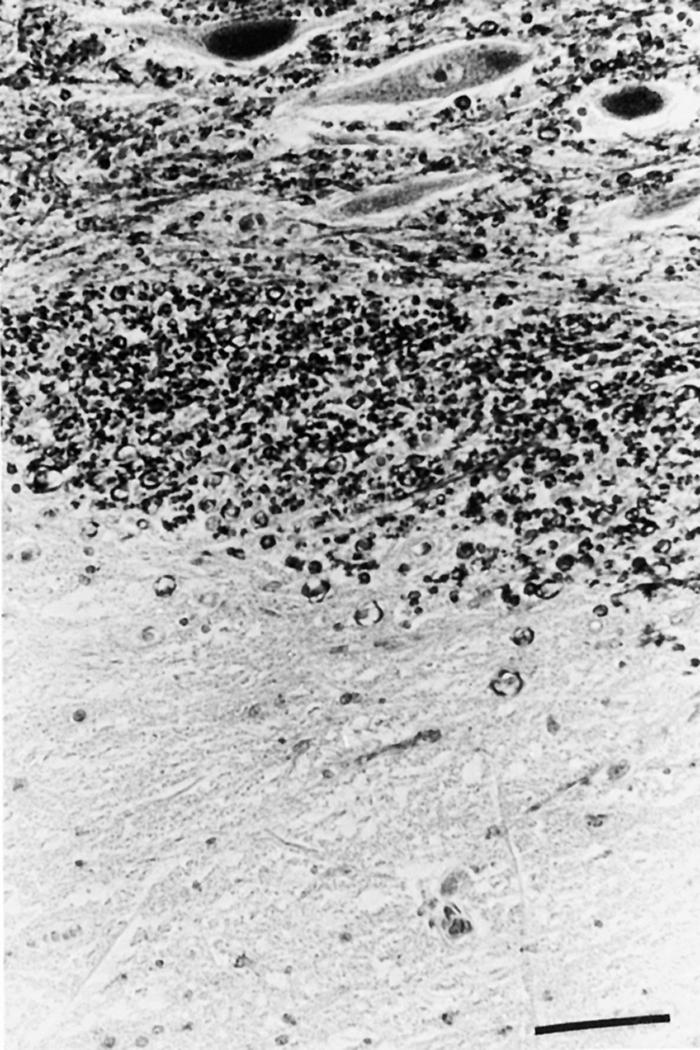
In progressive MS, ongoing low-grade demyelination is found at the borders of plaques, and this may explain the slow expansion of plaques and occurrence of more diffuse inflammation leading to progressive loss of function ( ).
Recent pathological studies have focused on the gray matter in MS and have found a lesion load within the cortex and deep gray structures. The nature of the intracortical plaques differs from those seen in white matter because there is less inflammation but considerable reactive microgliosis ( ).
Low levels of autoreactive T cells and B cells are present in normal individuals. Presumably they have escaped from clonal deletion during the process of immune development and are now tolerant of their antigens. Autoimmunity develops when these cells lose tolerance and a complex process of immune reactivity in target tissues begins. One potential way tolerance can be broken is by means of molecular mimicry between self-antigens and foreign antigens—for example, viral components. Several viral and bacterial peptides share structural similarities with important proteins of myelin, and a few of them are able to activate specific T-cell clones derived from patients with MS. Another way tolerance can be broken is by CNS infection that causes tissue damage and antigen release into the peripheral circulation, where corresponding autoreactive T cells may be encountered.
Myelin basic protein (MBP) has long been considered one of the primary candidates for an autoimmune attack. T cells that respond to MBP are found in the peripheral blood in both normal persons and those with MS, possibly at higher levels in MS patients with active disease. MBP, which accounts for 30% of the protein of myelin, can be an antigen for EAE, the primary animal model of MS.
Several other myelin proteins are also candidates for an autoimmune attack. Proteolipid protein accounts for 50% of CNS myelin protein and is an integral membrane protein of the myelin leaflets. Myelin-associated glycoprotein, myelin oligodendrocyte glycoprotein, and cyclic nucleotide phosphodiesterase are proteins that each account for a few percent of myelin. Myelin oligodendrocyte glycoprotein and cyclic nucleotide phosphodiesterase are not found in peripheral nerve myelin and are therefore of special interest.
Although the possibility of pure autoimmunity as the causal mechanism for MS exists, the issue is not proven. The evidence for MS being a dysimmune condition is more compelling; with alterations in the immune cell repertoire and activation state both in blood and cerebrospinal fluid (CSF) of MS patients compared to others ( ).
MS is a genetically complex disease. Compared to the general population, a higher frequency of familial occurrence of MS suggests a strong but non-Mendelian inheritance of susceptibility. Twin studies established the importance of genetic factors: the concordance rate for a clinical diagnosis of MS in female monozygotic twins is about 30%, whereas in dizygotic twins it is 2%–5% ( ). The risk is highest for siblings: 3%–5%, or 30–50 times the background risk for this same population. Adoptive relatives, when raised from infancy with the patients with MS, are no more likely to develop MS than the general population.
MS is associated with both MHC and human leukocyte antigen (HLA) class I A3 and B7 antigens. The class II polymorphisms, Dw2 and DR2, also show strong association, and specifically the HLA DRB1∗1501 allele ( ). Additional HLA alleles that carry protective as well as detrimental effects with regard to MS susceptibility have been identified. HLA-A∗02, for example, has a protective effect relative to MS susceptibility. Additional MS susceptibility loci outside of the MHC have been described. Specifically, the loci coding for IL-7 receptor and IL-2 receptor are strongly linked with MS susceptibility ( ). IL-7 and IL-2 receptor signaling is critical for the differentiation of CD4 − CD8 − thymocytes and has a role in survival of CD4 + CD8 + cells after positive selection. This may be important not only in MS predisposition but also in disease course and outcome.
In recent years, multiple genome-wide association studies (GWAS) have been performed, allowing for the analysis of a larger number of genetic variants that individually have a small, but still significant, impact on MS risk. Greater than 230 genetic variants have been identified through these studies, yet combined they account for only 20% of the heritability risk. Recently, an important study analyzed 32,367 MS cases and 36,012 controls and found 4 novel gene variants that independently contribute an additional 5% risk (International Multiple Sclerosis Genetics Consortium: chris.cotsapas@yale.edu & ). Although there have been clear advancements in this area of study, current knowledge of MS genetics has not enabled the creation of reliable diagnostic or prognostic tools for use in the clinic.
A possible role for microbial infection in the causation of MS has been a matter of ongoing debate for decades. However, beyond speculation, little direct evidence supports the concept. Specific efforts to recover a known viral genome have been fruitless. Despite this, in recent decades pathogens such as human herpesvirus 6 (HHV6), Epstein-Barr virus (EBV), and Chlamydia pneumoniae have been the focus of interest as potential triggers for MS.
Perhaps the most compelling argument has been made for a possible role for EBV in MS pathogenesis. Although EBV is extremely common in the population, with a prevalence between 90% and 95%, multiple studies have shown seroprevalence to be greater than 99%, though importantly not 100%, in MS patients. Furthermore, history of infectious mononucleosis, as opposed to the more common asymptomatic EBV infection, seems to further predispose to risk for MS ( ). Potential mechanisms invoking EBV in the development of MS include an inappropriate autoreactive immune response as the result of molecular mimicry or a more direct role of the EBV virus promoting persistent inflammation in the CNS ( ).
Although there is no definitive evidence for vitamin D deficiency as a causative factor in the pathogenesis of MS, low levels of vitamin D have now been associated with an increased risk for MS in many different studies. Early epidemiological studies in MS noted an increasing prevalence of MS in populations at increasing distances from the equator. This led to the hypothesis that decreasing levels of vitamin D, related to lower levels of sun exposure, could explain this phenomenon. Cohort studies supported this theory, as vitamin D supplementation was inversely related to the risk for MS in two groups of nurses ( ), and similarly, the highest serum levels of 25-hydroxy vitamin D correlated to the lowest risk for MS and vice versa in a group of 7 million US military recruits ( ). Multiple studies since have also shown this association. Furthermore, the correlation between low serum vitamin D levels and an increased risk for continued MS disease activity has been made both radiologically ( ) and with data from a clinical trial cohort ( ). The SOLAR trial is the largest completed trial to date of vitamin D supplementation in MS. This 48-week, double-blind placebo-controlled trial of high-dose (14,000 IU daily) vitamin D 3 as an add-on to 44-μg scIFN β-1a did not find a difference in disease activity free status or in relapse rate between the groups ( ). Thus, despite many indications of the role of vitamin D in MS, it remains to be seen if supplementing an MS patient can alter the disease course.
The association between smoking and an increased risk for MS has been established with evidence from multiple case control studies. Smoking increases the risk of developing MS and the risk of conversion from CIS to clinically definite MS (CDMS; ). There is also evidence, albeit weaker, that smokers have a more severe course than nonsmokers ( ). Smoking is thought to be a direct neurotoxin, but also may bring about immunomodulatory changes that promote inflammation ( ).
Although several studies have linked MS and childhood obesity ( ; ), there are no specific dietary factors that are known to provoke or ameliorate the MS course. However, there is a plethora of ongoing research in this area. Likewise, the human microbiome is also a topic of interest in relation to the risk of getting MS, as well as to its impact on the MS course. Thus far, researchers have been able to show that both adult and pediatric patients with MS do have a different microbiome signature than people without ( ). Furthermore, treatment with MS disease-modifying therapies (DMTs) also has been shown to impact the composition of the microbiome ( ). However, further work needs to be done to understand the complexities of the relationship between the microbiome and MS.
Most studies agree that the mean and median age of onset in relapsing forms of MS is age 29–32. The peak age of onset is approximately 5 years earlier for women than for men. Primary progressive multiple sclerosis (PPMS) has a mean age of onset of 35–39 years. It is well recognized that the onset of MS can occur well outside of these ranges; 5% of cases of MS have their onset before age 18. Most of these cases occur in adolescence, but a small percentage have an onset in the first decade of life ( Fig. 80.6 ). Patients may also present with first symptoms after age 50, in 3%–12% of incident cases ( ).
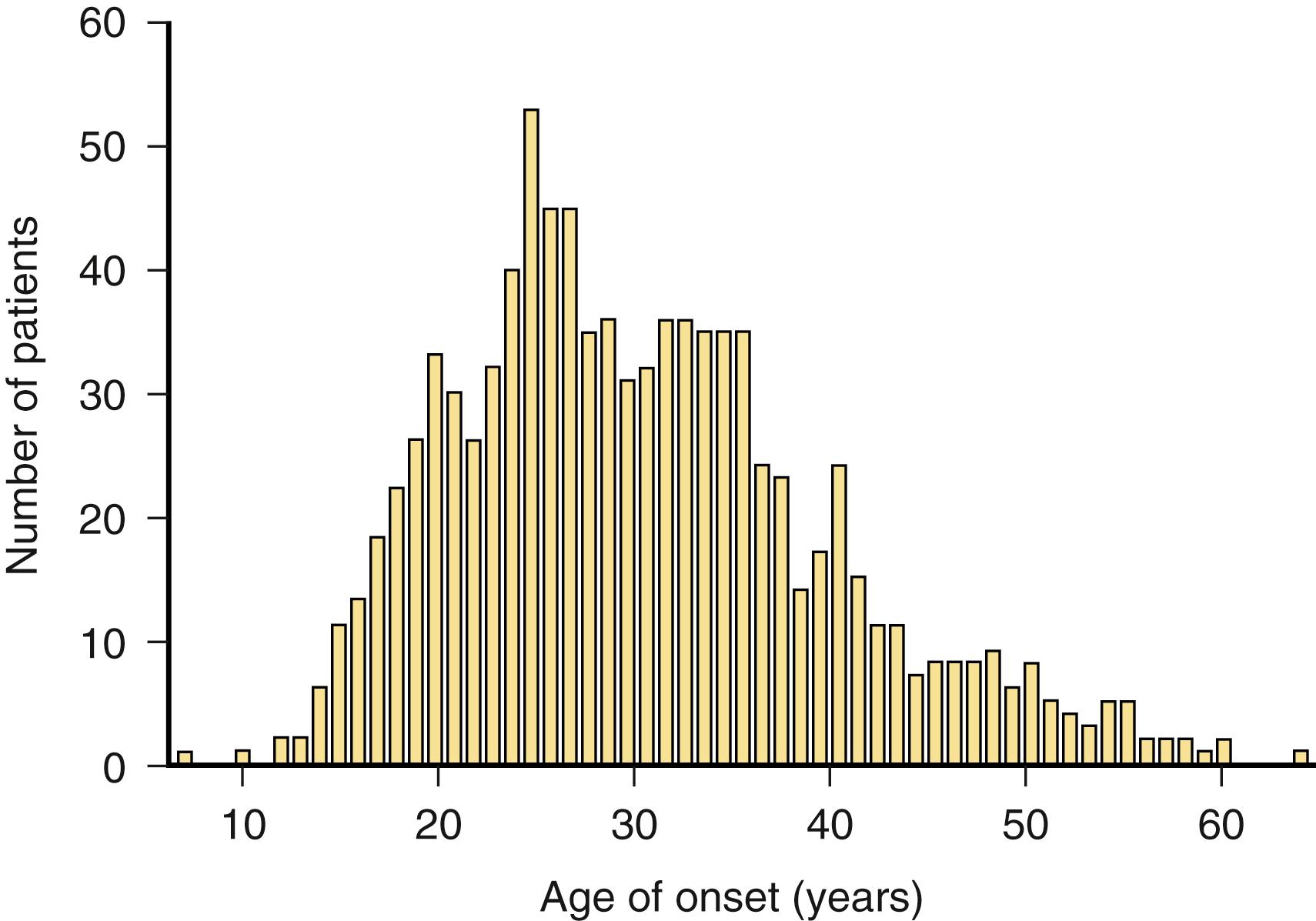
Similar to most other autoimmune conditions, MS affects more women than men. During the 20th century the female:male ratio of incident relapsing MS cases has increased in most geographic locations ( ). Although some have hypothesized that this is due to ascertainment bias (milder cases in females discovered through increased use of MRI and more sensitive diagnostic criteria), most agree that changes in childbearing patterns and epigenetic and environmental factors also likely contribute to this trend ( ). The female:male ratio in relapsing-remitting MS in most countries is 2–3:1, although interestingly it has remained steady at 1:1 in PPMS ( ).
Hundreds of prevalence surveys have been carried out, serving as the basis for the delineation of geographical risk for MS depicted in Fig. 80.7 . Worldwide, it is estimated that in 2016 2.2 million people had MS, which is 10.4% more cases than in 1990 ( ). High-frequency areas of the world include all of Europe (including Russia), southern Canada, the northern United States, New Zealand, and the southeastern portion of Australia. In many of these areas, the prevalence is far greater than 100 cases per 100,000. The largest increase in MS prevalence has been in Canada where there has been an 82% upsurge in the last 25 years. The number of cases of MS in the United States was estimated by the National MS Society in 2002 to be approximately 400,000 persons, yet more recent 2017 estimates are greater than 900,000 ( ). The rise in numbers is likely due to a combination of factors, including more sensitive criteria for diagnosis and increased survival.

One possible conclusion, as mentioned above, regarding geographical differences in prevalence is that MS is a location-related illness with a latitude gradient. However, this risk is clearly modulated genetics, as notable exceptions exist. Japan, situated at the same latitude as areas of high prevalence in Europe, is a low-risk area. Second-generation Japanese in the United States retain their parents’ low risk of MS. The White population of South Africa, with medium prevalence of MS, is surrounded by a Black population in whom the disease is very uncommon. Native North Americans, especially of pure Amerindian background, have a very low prevalence but are surrounded by a White population with a medium or high risk for MS. People of Asian, African, or Native American origin have the lowest risk.
Migration data have often been used to support the view that an environmental agent is involved in the pathogenesis of MS. The data indicate that persons migrating from an area of high risk to an area of low risk after the age of puberty carry their former high risk with them. With migration during childhood, the risk seems to be that of the new area to which the person has migrated.
Most studies of MS and mortality have shown that MS shortens life span, on average, by a period of 7–14 years ( ). Death due to a catastrophic MS relapse is extraordinarily uncommon. Although MS is listed as the primary cause of death on an MS patient’s death certificate approximately 50% of the time ( ), more typically an infection or other complication of progressive MS is the actual cause. Cardiovascular disease, accidents, and suicide seem to be represented in a higher proportion in the MS population.
The evidence suggests that the increased rate of death in patients with MS does seem to be declining relative to that of the general population. In Denmark, an exceptionally complete survey of the country found the median survival after diagnosis for men was 28 years and for women 33 years, compared with matched population death rates of 37 and 42 years, respectively. The 10-year excess mortality was reduced by 50% in recent decades, even before the introduction of DMTs ( ). This trend seems to have continued in the post-DMT era. In another important study, a 21-year follow-up that included 98.4% of the patients enrolled in the pivotal IFN-β-1b trial, the risk for death in patients initially randomized to IFN-β-1b 250 μg was found to be decreased, with a hazard ratio (HR) of 0.53 versus those initially on placebo ( ), thus suggesting that early initiation of DMT might further alter mortality outcomes. These findings were replicated in a case-control study where greater than 3 years of IFN-β reduced the chance for death by 32% in a cohort composed of Canadian and French patients ( ).
In a condition such as MS, where a diagnosis proven by biopsy is rare and undesirable in almost all cases, formulating criteria that produce an accurate diagnosis through other means is of crucial import. There have been multiple sets of diagnostic criteria utilized over the years, in an effort to assist the clinician in making the correct diagnosis as well as to allow the researcher to identify those appropriate for studies. The common thread among all MS diagnostic criteria has been the requirement for symptoms and signs that are disseminated in time and space (more than one episode involving more than one area of the CNS).
Before 2001, the accepted criteria allowed for the diagnosis of MS based on clinical features alone—namely, history and physical examination—with support for the diagnosis gained by the use of CSF analysis, evoked potentials, and neuroimaging. In the Poser criteria, used from 1983 to 2001, a patient must have had two clinical attacks with evidence to support this on examination in order to be diagnosed with CDMS.
In 2001, McDonald and colleagues initiated the modern era of MS diagnosis by proposing diagnostic criteria that permitted activity on follow-up MRIs to substitute for a second clinical attack in order to meet dissemination in space (DIS) and dissemination in time (DIT). These criteria maintained an acceptable level of diagnostic sensitivity and specificity despite less rigorous clinical requirements. Importantly, incorporating subclinical activity on MRI into the criteria allowed for the diagnosis of MS to be made sooner, instead of waiting for additional clinical episodes as diagnostic confirmation.
The McDonald criteria were most recently revised in 2017 ( ) ( Table 80.1 ). This version aimed to refine the earlier iterations, with only minor changes made. Like the previous 2010 criteria, at least one characteristic demyelinating episode is required in order to diagnosis relapsing-remitting multiple sclerosis (RRMS). DIS is satisfied if MRI reveals ≥f1 lesion in two out of four typical locations: periventricular, cortical/juxtacortical, infratentorial, and spinal cord. Here, the most important change is that cortical lesions were added as a typical lesion location interchangeable for a juxtacortical lesion. For the DIT criteria, the requirement is met when there is simultaneous presence of gadolinium-enhancing and nonenhancing lesions at any time, or a new T2 or T1 gadolinium-enhancing lesion on a follow-up MRI scan. To contrast, the 2010 criteria mandated that symptomatic lesions in the brainstem and spinal cord could not be used to support DIS or DIT.
| 2017 revised McDonald MS diagnostic criteria ∗ Diagnosis of MS requires elimination of more likely diagnoses and demonstration of dissemination of lesions in space (DIS) and time (DIT) |
| Clinical (Attacks) | Lesions | Additional Criteria to Make DX |
|---|---|---|
| 2 or more | Objective clinical evidence of ≥2 lesions or objective clinical evidence of 1 lesion with reasonable historical evidence of a prior attack | None. Clinical evidence alone will suffice; additional evidence desirable but must be consistent with MS |
| 2 or more | Objective clinical evidence of 1 lesion | DIS; OR await further clinical attack implicating a different CNS site |
| 1 | Objective clinical evidence of ≥2 lesions | DIT; OR await a second clinical attack OR demonstration of CSF-specific oligoclonal bands |
| 1 | Objective clinical evidence of 1 lesion | DIS; OR await further clinical attack implicating a different CNS site AND DIT; OR demonstrations of CSF-specific oligoclonal bands OR await a second clinical attack |
| 0 (progression from onset) | One year of disease progression (retrospective or prospective) AND at least two of: DIS in the brain based on ≥1 T2 lesion in periventricular, cortical/juxtacortical or infratentorial regions; DIS in the spinal cord based on ≥2 T2 lesions; positive CSF |
∗ Thompson, A, Banwell, B, Barkoff, F., 2018. Diagnosis of multiple sclerosis: 2017 revisions of the McDonald Criteria. Lancet Neurol. 17(2), 162–173 .
One key addition to the 2017 criteria is the use of lumbar puncture to confirm a diagnosis. For patients with only one clinical event that meets DIS criteria, positive oligoclonal bands (OCBs) in the CSF now can substitute for DIT. This decision was made based on multiple studies that show that positive bands are an independent risk factor for further clinical activity ( ). Additionally, the panel maintained that the clinician should ascertain disease phenotype at diagnosis, and should periodically reassess.
MRI is the preferred imaging modality for both making the diagnosis of MS and longitudinal follow-up of patients. MRI is based on relaxation properties of water in tissues and is sensitive to T2 (transverse) and T1 (longitudinal) relaxation rates of protons. Gadolinium (Gd) diethylenetriamine penta-acetic acid (DTPA) is a paramagnetic contrast agent. It crosses the disrupted BBB, indicating increased vascular permeability in association with inflammation. Gd enhancement is best seen on spin-echo T1-weighted imaging. These fundamental properties of MR image acquisition provide a sensitive measure of pathology; areas of brain inflammation, demyelination, and loss of axons can be especially well seen with this technique. Virtually all patients with MS have T2 and fluid-attenuated inversion recovery (FLAIR) abnormalities. New lesions occur 9–10 times more often than new clinical attacks in RRMS.
Characteristic cerebral lesions, or plaques, are focal and discrete, have an ovoid appearance, and are oriented perpendicularly to the plane of the lateral ventricles. These are classically referred to as Dawson’s fingers and are thought to represent perivenular inflammation, seen pathologically in MS plaques. Additionally, lesions are characteristically located in the deep white matter and the centrum semiovale, as well as in cortical and deep gray-matter structures. Juxtacortical lesions affecting U-fibers are often seen in MS. Posterior optic radiation lesions are also frequently present. Posterior fossa lesions are commonly present in the cerebellum, middle cerebral peduncles, and in areas adjacent to the fourth ventricle ( Fig. 80.8 ).
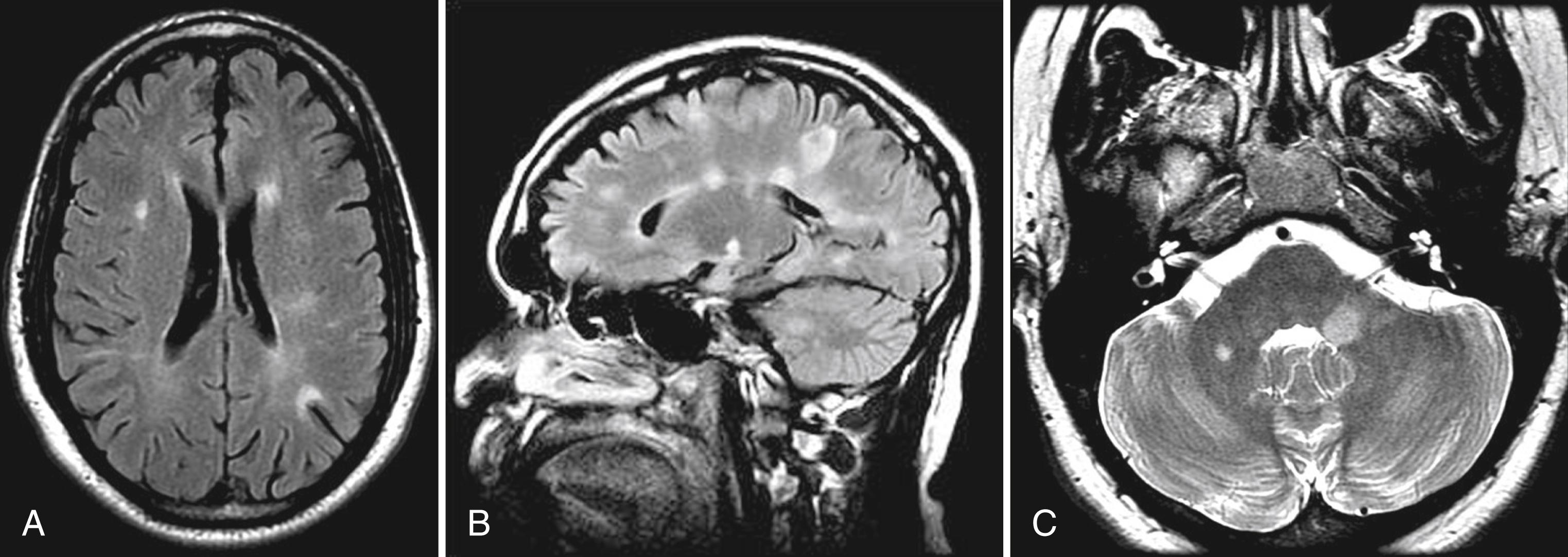
MRI is a helpful tool to distinguish between acute, subacute, and chronic MS lesions. Acute lesions of less than 12 weeks duration often show Gd contrast enhancement on T1-weighted sequences, indicating inflammation and BBB disruption. Enhancement patterns can appear as incomplete or, less commonly, complete rings, or as patchy or homogeneously enhancing lesions ( Fig. 80.9 ). Ring-enhancing lesions are associated with significant tissue destruction ( ). They may also be associated with a bright signal on diffusion-weighted imaging (DWI). Contrast-enhancing lesions are most often associated with a bright T2 or FLAIR signal, denoting an acute MS lesion. Acute MS lesions tend to be larger in size, with less well-defined margins. Infrequently, acute T2 bright lesions can disappear on subsequent scans, indicating reversible tissue inflammation and edema. At times, acute MS lesions may show an associated dark signal on T1 noncontrast scan (acute T1 lesion), consistent with edema and demyelination. Subacute MS plaques may no longer show contrast enhancement but may continue to show bright DWI abnormality. Chronic MS plaques appear hyperintense on T2 or FLAIR sequences, are usually smaller, and have sharper margins. Persistent and profound T1 hypointensity (also known as a “black hole”) usually reflects irreversible tissue damage such as axonal loss and permanent demyelination ( ; Fig. 80.10 ).
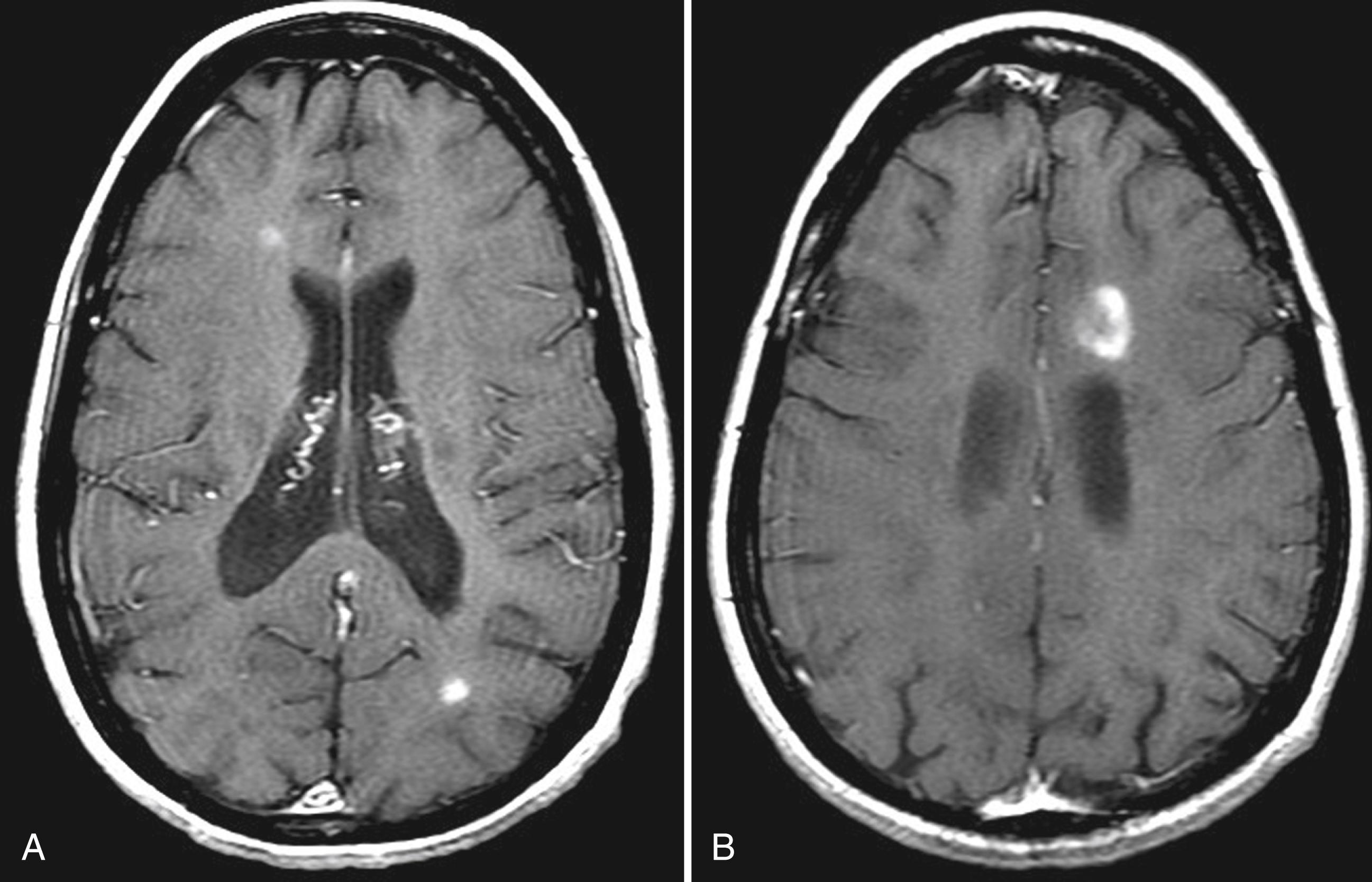
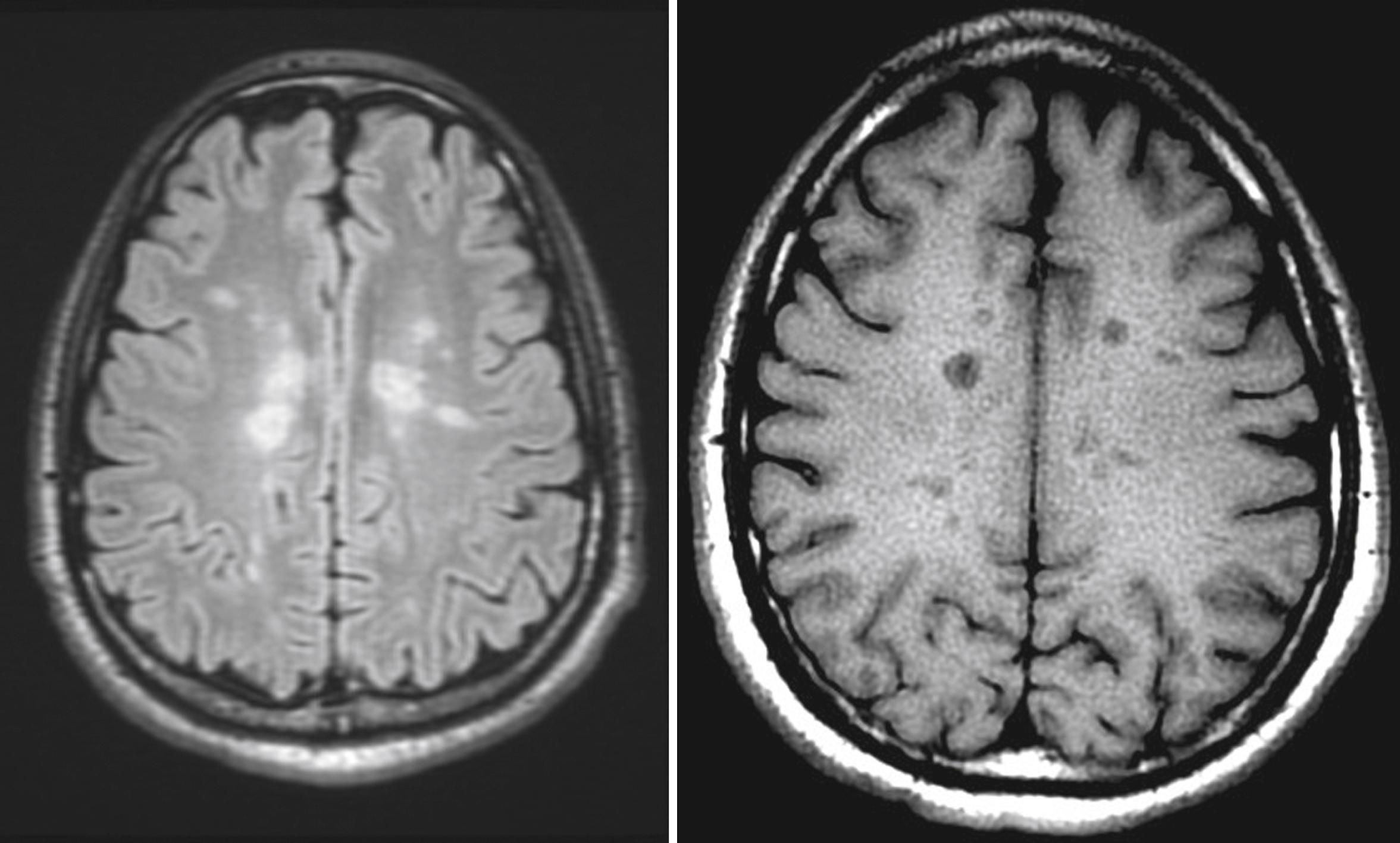
Become a Clinical Tree membership for Full access and enjoy Unlimited articles
If you are a member. Log in here